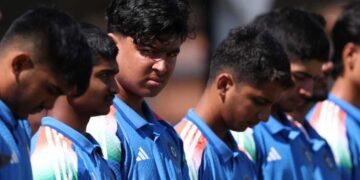South Africa have been the most unfortunate side in the World Cup so far. In 1992, they made their World Cup debut in Australia but failed to win the trophy after their 19-run loss to England in the semi-final. In their maiden World Cup exit, the Most Productive Overs wrecked their dream to lift the trophy.
The Proteas have played in eight World Cup installments so far but never succeeded in clinching the distinguished trophy. After making their World Cup debut, they have qualified for the semi-final in every alternate edition. If South Africa reach the semi-final again in the 2023 World Cup, they will look to clinch the trophy under Temba Bavuma.
South Africa aren’t the favourites to win the World Cup 2023, this time, but noting their decent One-Day International (ODI) record in India, they can’t be written off. In the last 10 years, South Africa are the only team that have won an ODI series in India along with Australia, who have won a couple of bilateral series against the Men in Blue. Talking more about the South Africa team’s preparation for the 2023 World Cup, let’s evaluate the strengths, weaknesses, opportunities, and threats of the Protea side.
Here is the SWOT analysis of the South African team
Strengths
Powerful batting line-up
South Africa have a strong batting unit that includes star-studded players such as Quinton de Kock, Temba Bavuma, Rassie van der Dussen, Aiden Markram, Heinrich Klaasen, and David Miller. Klaasen looked in a great rhythm with the bat ahead of the 2023 World Cup. In the five-match ODI series against Australia, the wicketkeeper batter entered the record books with his 57-ball hundred in the fourth ODI at the SuperSport Park Cricket Stadium.
Aiden Markram also performed consistently with the bat. In 2023, the 28-year-old is averaging around 65.00. Appearing in 11 ODIs this year, Markram has scored 577 runs at a strike rate of 119.70. In South Africa’s ODI series victory against the Aussies, Markram played an instrumental role. He notched up 225 runs in five games at a strike rate of 115.97 and received the Player of the Series award.
Temba Bavuma and Quinton de Kock also looked decent in the Australia series and in the upcoming World Cup, their endeavours will be to be better in their roles. David Miller is the most experienced player in the squad and his job will be to play the role of match-finisher efficiently in the lower middle order.
Fine pace attack
Kagiso Rabada will spearhead South Africa’s pace attack in the upcoming World Cup. The speedster has more than eight years of experience in ODI cricket and his responsibility will be to provide early breakthroughs to his team with the ball in the tournament. He has added 144 wickets to his profile in 92 ODIs played in his international career.
Rabada will be assisted by Lungi Ngidi, Andile Phehlukwayo, and Marco Jansen to strengthen the fast-bowling unit. Jansen put up an impressive show with the ball in the home series against Australia. In the final ODI in Johannesburg, he grabbed a five-wicket haul and guided his team to a 122-run win.
Weaknesses
Anrich Nortje’s absence
Anrich Nortje won’t be a part of South Africa in the 2023 World Cup. The paceman got ruled out of the entire tournament due to a lower back injury. Nortje could’ve formed a perfect pace trio along with Rabada and Ngidi to trouble the opponents with their combined fast-bowling strength. Considering Nortje’s extraordinary bowling talent, it won’t be easy for the South Africa team to fill his shoes.
South Africa’s World Cup record in the sub-continent
In the 1996 World Cup, South Africa played their first World Cup in the sub-continent and failed to qualify for the semis. In the tournament jointly hosted by India, Pakistan, and Sri Lanka, the Proteas ended up at the top of the table in the group round but lost to the West Indies in the quarter-finals in Karachi and got eliminated from the competition.
The World Cup returned to the sub-continent in 2011 and this time, South Africa looked amazing in the group round again. With 10 points in six games, South Africa ended up as the table-toppers under Graeme Smith’s captaincy. However, like the 1996 World Cup, the team stumbled in the knockouts again. This time, they lost to New Zealand by 49 runs in Mirpur.
Mediocre spin attack
South Africa aren’t carrying quality spinners with them for the 2023 World Cup. Tabraiz Shamsi and Keshav Maharaj will handle the spin attack but their inexperience and below-par numbers in the sub-continent country might give chills to the Protea cricket team supporters. Tabraiz has played only one ODI in India, in which he got only one wicket at an expensive economy of 11.12. Similarly, Keshav has also played only two one-day matches in India and he also struggled to be among the wickets, picking up only one scalp.
Opportunities
In the 2023 edition, South Africa aren’t the favourites to clinch the trophy. This negative factor will help Bavuma and his boys to perform well without any pressure. In the previous World Cup editions, it has been witnessed how South Africa choked in crunch situations and lost the chance to grab the trophy.
Another factor that will help the South African team to do well in this World Cup is their players’ experience on Indian soil. South Africa stalwarts such as David Miller, Quinton de Kock, Aiden Markram, Heinrich Klaasen, and Kagiso Rabada have played a lot of cricket in India. These players have toured the sub-continent country several times for bilateral series and the Indian Premier League (IPL).
Threats
South Africa’s biggest threat is their infamous chokers’ tag. The Proteas are known for failing to hold their nerves in ICC tournaments. In the 1996 World Cup, they lost to the Windies side in the knockouts after performing brilliantly in the knockouts. While in the 1999 edition, the tie against Australia in the semi-final in Birmingham forced them to exit the tournament.
In 2003, South Africa were the favourites to bag the trophy as one of the hosts but the miscalculation in the game against Sri Lanka kicked them out of the competition. Competing against the 1996 World Cup champions in Durban, the hosts were required to score 269 but with the interruption of rain, the match ceased in the 45th over of South Africa’s innings.
Mark Boucher, who was at the crease, felt that the team had scored enough runs to win so he played the last delivery of the game for a dot which levelled the scores of both sides. In the end, the match ended in a tie, and South Africa got eliminated from the tournament as it was a do-or-die contest for them. After 2003, South Africa got nervous in the 2011 and 2015 editions as well. In both World Cup installments, they lost to New Zealand. South Africa’s one of biggest challenges in the upcoming competition will be to get rid of their tendency to choke in big games.





































